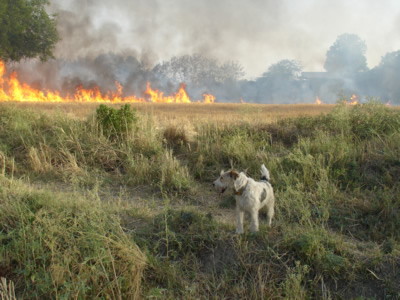Why Turn Punjab Into A Fire Ball
By Devinder Sharma
12 October, 2011
Countercurrents.org

This is how Punjab (and for that matter much of Indo-Gangetic plains) looks like at the time of paddy harvest.
Come October, and travelling through Punjab especially in the evenings becomes a pain. With smoke bellowing out from crop fields, irritation/itching of eyes is accompanied by difficulty in breathing and chest congestion. It isn’t a day’s problem; people living in Punjab have to continuously bear this torture for the better part of October and November, sometimes extending into early December.
Aware of the resulting impact on human health and environment, in a few days from now, on October 13, over 20 lakh school children will take out awareness walks in all Punjab villages to educate farmers about the destructive fallout of burning paddy stubbles in their crop fields. A brainchild of Punjab Pollution Control Board, the state-wide march by school students is certainly a welcome initiative. The Board is also impressing upon the CBSE to ensure that their schools too join the campaign, which will last for a month.
It is essentially in the two and half months after paddy harvest, the entire Indo-Gangetic plains stretching from lower Himachal Pradesh to Punjab, Haryana and western parts of Uttar Pradesh literally turns into a furnace. It is a usual practice for farmers to put the paddy stubbles after harvest to fire in a bid to clear the crop field for the sowing of the next wheat crop. This harmful operation, which causes severe environmental pollution besides damaging the soil, has been going on unchecked for years now.
Seen from the sky, as the satellite images show, Punjab literally appears to be more or less like a fire ball. It appears red in colour, with dark spots concentrated in the paddy growing areas. Despite the imposition of a ban on burning of paddy straw, it is believed that of the estimated 100 million tonnes of paddy straw that is produced in Punjab, roughly 85 per cent is burnt. If measured in terms of energy equivalent, this is approximately equal to 30-40 million tonnes of coal. A massive loss you will agree.
A recent study has computed the resulting health damage from the burning of paddy straw in Punjab alone at Rs 7.6 crore a year. On an average each household adds Rs 1000 to its medical bill every month. In addition, there are expenses that farmers have to make by way of more application of chemical fertilisers, and pesticides, and also the loss he undergoes in soil nutrients, vegetation and biodiversity, which has not been included.
This unwanted practice must stop. I therefore feel excited that the school children have taken on the responsibility to put an end to the burning of a massive biological waste. They have already played a very crucial and defining role in stopping the use of plastic carry bags forcing several State governments to impose bans; and also the impact their campaigns have made on effectively limiting the use and abuse of fire crackers on Diwali. Children therefore can be the right medium to make farmers aware of the need to abandon the damaging practice of burning paddy straw, and may force them to switch to greener options to utilise the waste.
I am only hoping that private schools too would be part of the effort. At some stage, college students too should be involved. After all, such an environmentally harmful practice has to change. Let us hope, the popular media, medical doctors, agricultural scientists and the average citizens too join hands in creating wider awareness to stop turning Punjab into a fire ball.
Devinder Sharma is a food and agriculture policy analyst. His writings focus on the links between biotechnology, intellectual property rights, food trade and poverty. His blog is Ground Reality
Comments are not moderated. Please be responsible and civil in your postings and stay within the topic discussed in the article too. If you find inappropriate comments, just Flag (Report) them and they will move into moderation que.


